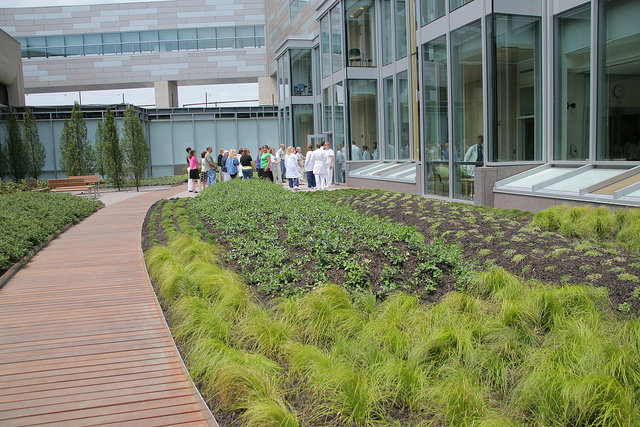Code Green Solutions


Employees touring various areas of the Healing Garden at the Hershey Cancer Institute in Hershey, PA
In line with how most of us feel when confronted with scenes of nature or time spent outdoors, there is a large body of evidence that suggests access to nature within health care settings promotes healing and overall well-being for patients, staff, and visitors. Increasingly, design standards for hospitals and other health care facilities encourage design that provides access to nature, including the Green Guide for Health Care and LEED for Healthcare.
“it is important to consider how individuals from different social and economic backgrounds might perceive green landscaping differently”As designs with access to nature become more prevalent, it will be important to make sure they are well implemented and are able to deliver the maximum positive impact. An article in Health Care Design, Designing Access to Nature in Healthcare, highlights a few important considerations. Looking at individual perceptions of green roofs, a study in Chicago and Toronto found that some people associated the messy look of prairie-style green roofs with neglect. While this viewpoint was held by the minority of study participants, it is important to consider how individuals from different social and economic backgrounds might perceive green landscaping differently. This difference in perception would then lead to a difference in the psychological impact of interaction with nature.
The article goes on to recommend steps to ensure equal access to the positive impacts of nature experiences. To negate the association of natural messiness with neglect, the author recommends “cues to care” to remind individuals of the care that is put in to the maintenance of green roofs and other landscaping. This could include educational signs explaining the natural features of the landscaping or visual cues such as straight mowed lines. It is also important to provide shade from sunlight in areas dedicated to interaction with nature to ensure that all patients, regardless of sunlight sensitivities, are able to benefit from the natural landscaping.
Another necessary consideration for incorporating in health care design, especially indoors, is management of pests, airborne pollutants, and other possible sources of infection, such as mold or fungi. To this end, both the Green Guide for Health Care and LEED for Healthcare include credits dedicated to infection control and indoor air quality optimization.